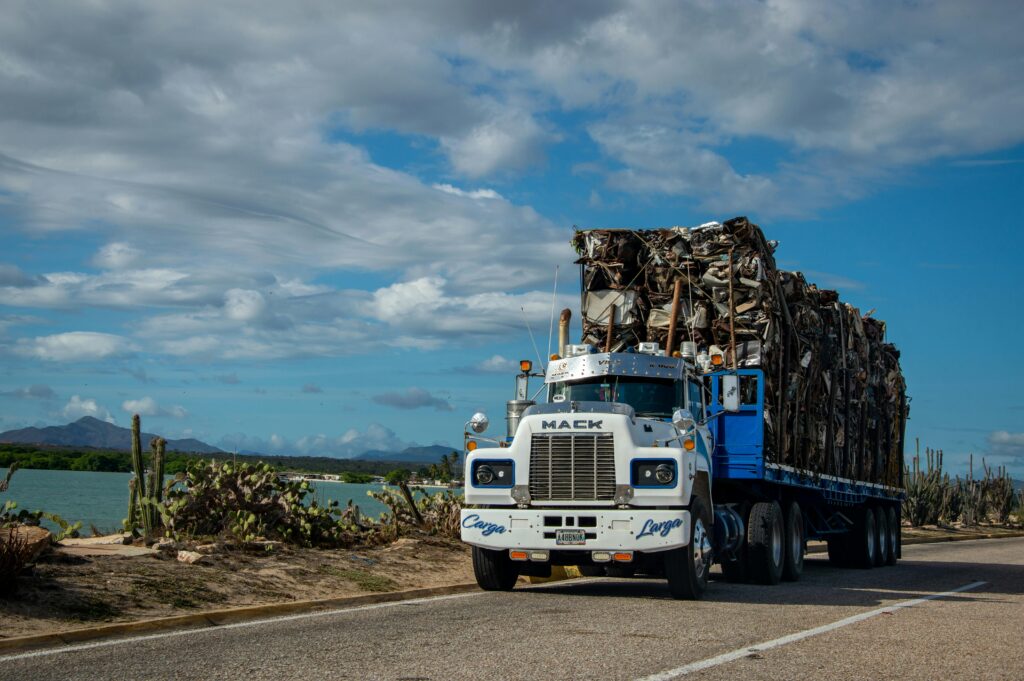Fleet managers and carriers have different responsibilities. That’s why they might not always see eye to eye.
While they may not always agree on the best way to use these reports, they certainly can both agree on one thing: the driver vehicle inspection report (DVIR) is crucial for running a safe, productive fleet.
For all the talk around the DVIR form, little has been mentioned about why a DVIR is critical for the health of a fleet. But before we learn about the utility, function, and benefit of a DVIR, it’s important to take a look at what exactly a DVIR is and how it can help you avoid breakdowns with your trucks, buses, and other fleet equipment.
Driver vehicle inspection report defined
A driver vehicle inspection report is very closely connected to a vehicle pre- and post-inspection (more on these inspections later). A DVIR is a formal print or digital record (the latter found in an app) that a commercial motor vehicle (CMV) driver has filled out and completed.
This form is based on the Department of Transportation’s (DOT) 49 CFR 396.11 and 49 CFR 396.13 laws stating that a driver needs to check their vehicle before and after operation to make sure the vehicle is in safe and working order.
The DOT says that the DVIR certifies that a proper inspection of the vehicle has been completed both before and after its use on the road. With this standardized process, fleet managers and drivers are better able to do their jobs.
DVIRs are a must for drivers and carriers
But why exactly can DVIRs help fleets better do their jobs? Because the DVIR helps create a more safe, reliable, and fleet team.
The purpose of the DVIR is to provide a standardized procedure for helping fleet drivers, managers, and shops to have accurate, accessible inspection records. When records are up to date, the whole team stands to benefit.
Fleet drivers can count on always having work, because their vehicles have been accounted for and are ready for action.
And fleet carriers? Fleet carriers, managers, and owners can count on increased profits knowing that they have a surefire way to keep tabs on their vehicles’ conditions.
If you’re not a driver or carrier, DVIRs can also affect you as well. Allow us to explain.
Benefits of DVIRs (for all people)
If we were creating a detailed list of the benefits of DVIRs, we could imagine that the list would be designed like a vine, with benefits spreading out from the roots up to the very top leaves.
Filling out timely, accurate, and consistent DVIR forms provide the following benefits to roadside users, drivers, and fleet businesses:
- Fewer accidents
- More on-time deliveries
- Safer roads
- Happier customers
- More loyal drivers to their fleet employers
- Having a reputation as a safe, reliable fleet business
As a result of reducing accidents and being on time with deliveries, carriers and drivers reduce the risk of the following potential stressful scenarios:
- Fines leveraged by the DOT (more about this in the FAQ section of this blog post)
- Insurance premium hikes resulting from potential accidents
- Increase in expensive repair costs from not being on top of inspections and repairs
- Civil defense litigation should an accident occur as a result of neglected repair work
- Leveraged criminal charges resulting from the accident
- Poor business reputation as a result of having criminal charges leveraged against you
Who completes a DVIR form?
One way to understand the multiple benefits that can result from filling out a DVIR form is to understand who needs to fill it out and for which reasons. The driver and the carrier both play an essential role — though they have different responsibilities — in filling out the DVIR form.
Drivers’ responsibilities
A fleet driver’s duties revolve mostly around the pre- and post-trip inspections.
A pre-trip inspection is a fleet-related term used to describe a thorough check of a vehicle — before the vehicle hits the road — to ensure everything is in proper working order. A post-trip inspection is — you guessed it — a check of a vehicle’s condition at the end of the day (or when the job is complete, when the vehicle is returned for the day, or when the vehicle is passed off to the next driver for another job).
The driver of the vehicle is responsible for conducting a prompt and thorough check of the vehicle and filing a report to the carrier, along with any defects, deficiencies, issues, repairs, or work done on the vehicle that the driver thinks the vehicle needs before its next operation.
A DVIR is then filled out at the completion of each day’s work only if a defect or deficiency has been discovered or reported by the driver. The vehicle carrier is then responsible for completing the next step in the DVIR form reporting process.
Carriers’ responsibilities
After the driver has filled out the pre- and post-inspection reports, the carrier must then complete a series of required procedures. The carrier must determine if a repair is needed for the driver-reported deficiency, defect, or issue.
In other words, the main task of the motor carrier involves repairs. If a driver reports or informs the carrier that there is a problem with the vehicle, the carrier must repair the vehicle and certify that a mechanic completed the maintenance and repairs needed on the vehicle and that there was a DVIR completed on the vehicle.
Now, in some instances, a carrier can also note that a repair is not needed. Though a driver must fill out a pre- and post-inspection report, if the carrier thinks the issues brought up by the driver aren’t needed, the carrier doesn’t have to repair the vehicle based on the driver’s recommendations.
However, that doesn’t make a carrier exempt from not filling out a DVIR.
Federal Motor Carrier Safety Regulations (FMCSR) states that carriers need to “review the last driver vehicle inspection report if required” and “be satisfied” that the vehicle is in “safe operating condition.” If repairs are needed, a certification is needed, and carriers must complete a DVIR report to make sure they’re meeting FMCSR requirements.
After corrective measures have been taken to ensure the safety of the vehicle, the carrier signs the report to acknowledge that the driver has completed a report and reviewed the DVIR form and that the necessary repairs have been performed.
What happens if I don’t complete a DVIR form?
A fleet operator, business, carrier, and driver must fill out a DVIR to stay in compliance with federal law and the Department of Transportation’s (DOT) federal requirements. Non-compliance with DVIR regulations can lead to severe penalties and jaw-dropping fines.
If a fleet fails to comply with DVIR requirements, a fleet can be liable to the following stress-inducing penalties and fines:
- $1,270 per day for failing to complete a DVIR when required
- Up to $12,700 for falsifying a DVIR form to hide defects
- Up to $15,420 for each instance in which a fleet fails to report and repair defects
It’s crucial to have your driver complete — and your carrier and mechanic review — completed inspections and forms to make sure your vehicles are safe for interstate commerce. Doing so will also help prevent defective passenger-carrying CMVs from causing potential crashes on the road.
DVIR-related FAQs
There are a few moving pieces to a DVIR form. As a result, navigating the various terms, phrases, and language in the FMCSR’s documents can be somewhat complex.
Here are some of the most common questions we’ve been asked by our customers. If you feel we missed something, just let us know! We’ll make sure to address your questions pronto.
What does a DVIR include?
The DVIR form reviews the following key identifying information:
- The date the report is filed
- The vehicle’s identifying information (fleet unit number, license plate number, vehicle identification number (VIN), and more)
- Signatures of the driver who prepared the DVIR, of the mechanic who repaired the vehicle (or determined a repair wasn’t needed), and the next driver of the vehicle who confirms that a repair was (or wasn’t) made.
Which vehicle parts are needed for inspections?
The following parts and accessories must be checked as part of the inspection process:
- Brakes (including service, parking, and hand brakes)
- Steering systems
- Tires, wheels, and rims
- Windshield wipers
- Rearview mirrors
- Horn(s)
- Emergency equipment
- Shaft and coupling devices
While the DVIR doesn’t need to include a list of these parts, including these key parts on your daily checklist will help with data collection for in-shop and mobile repair work. Reviewing these parts will ultimately help you make real-time decisions to keep drivers and passengers safe on and off the road.
How often does a DVIR form need to be completed?
A DVIR form must be completed before a commercial vehicle goes out for work and after it returns at the end of the day. Keeping your fleet up to date on the required procedures for compiling a DVIR form and any additional information pertaining to when the DVIR needs to be completed will help your mechanics and office associates keep your fleet well-organized.
How long is a DVIR form filed for?
A DVIR form is kept on file for three months. It may be discarded after three months have passed.
We recommend storing files for longer just in case you need to retrieve them for the future.
Certified drivers, expert technicians, quality service guaranteed
Completing a DVIR can take time. But with proper data hygiene and protocols in place, your fleet can maximize its profitability, safety, and security on the road.
If you’d like additional help with your DVIR forms, pre- and post-inspection checklists, or more, don’t hesitate to reach out to a fleet repair shop. It’s the best way to go.
At Certified Fleet Services, we’re all about helping drivers and fleets get back on the road faster. That’s our guarantee to you.
If you’re looking for an ordinary, bare-bones repair shop, a quick Google search should do the trick. But if you’re looking for something extraordinary — certified drivers, expert technicians, top-quality service, and excellent customer service — we fit the bill. Contact us today to receive additional information for your DVIR process.









